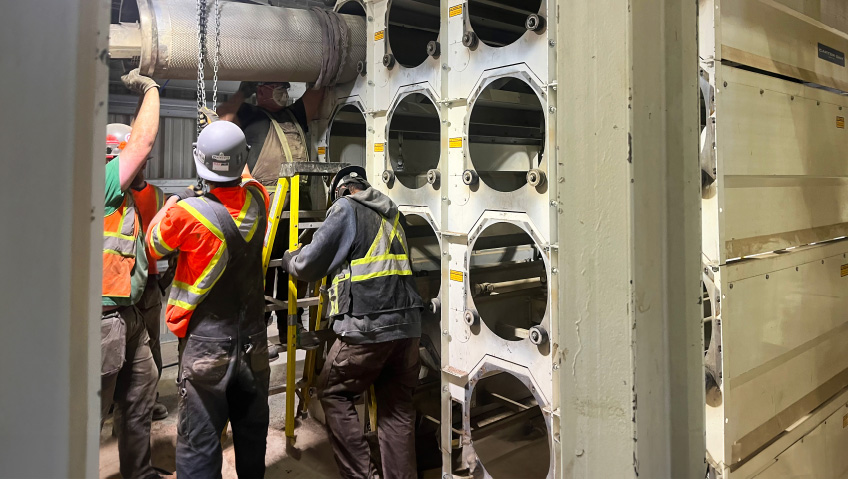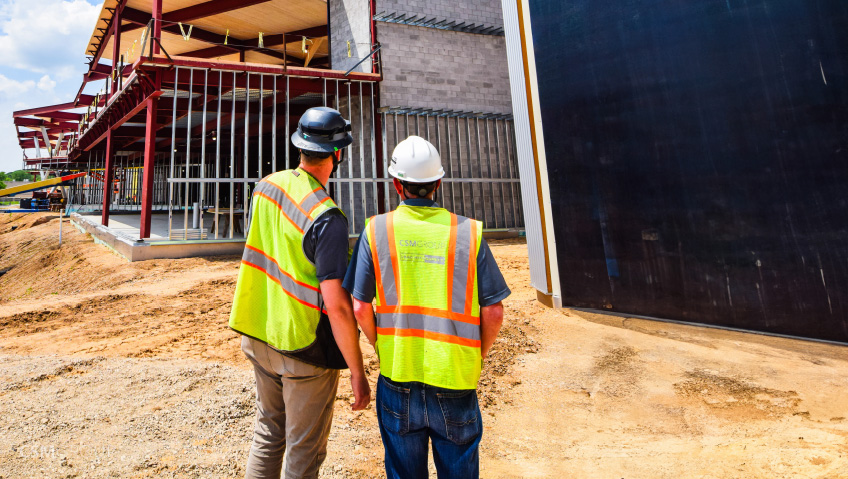Every construction site has potential hazards, from risks like tripping and falling to being hit by falling materials or equipment, to electrocution. Personal protective equipment (PPE) like gloves, hard hats, safety glasses, and steel toe boots help protect our bodies—but much more is required.
In the summer, temperatures in Florida can exceed 110°F (43.3°C). With its humid subtropical climate, Florida is high on the list of the 10 hottest states. The historic city of Pensacola is renowned for its beauty but also its hurricanes, owing to its location in the Florida Panhandle. Most recently impacted by Hurricane Sally in 2020, parts of Pensacola experienced more than two feet of rain, the partial collapse of the city’s 3-Mile Bridge, power outages, and shortages of everything from food to drinking water—totaling over $300 million in damage and incalculable losses for the disruption of livelihood of the area’s residents.
For Florida’s construction workers, there is the risk of not only heat and the elements, but even of wildlife, including alligators and snakes in marshy areas. Fortunately, the team at Bear General Contractors not only takes every aspect of safety seriously; they have built their reputation on it.
Safety first
Keeping employees, contractors, clients, and the public safe at all times isn’t an option for Bear General Contractors; it is an absolute necessity. Founded by long-time friends Chris Jaubert and former NFL Super Bowl Champion, Josh Sitton, the Pensacola-based construction company specializes in renovation and new commercial building construction, and is licensed in Florida, Alabama, and Louisiana.
Created in 2014, Bear started out taking smaller tenant fit-out jobs. In a short time, the company began taking projects in the $100,000 range. Today, most work begins at $250,000 on the low end, averaging between $5 million and $8 million. On the very high end, the business was responsible for a large-scale high school athletic complex exceeding $46 million in value.
Even in the company’s early days, safety was a priority. Extensive training, regular job site visits, training in heat stress, new employee safety orientation, OSHA training, and more are just the beginning. Bear General Contractors benefits from the experience of veteran Health and Safety expert Bruce Higdon—a Certified Safety Professional. His extensive experience includes construction safety, chemical hazards mitigation for Union Carbide, and managing safety for 13 paper mills. He is also an Industrial Hygienist. Higdon regularly develops training modules, performs walk-throughs with superintendents and foremen, and identifies existing and potential hazards. Most notably, Bruce was recently awarded the 2023 – 2024 Safety Professional of the Year award by the Pensacola Chapter of the American Society of Safety Professionals.
To say that Bear General Contractors’ safety record is enviable is an understatement. The company has achieved Platinum in the Associated Builders and Contractor’s (ABC) STEP Safety Management System, a world-class safety program, along with ABC’s top designation as an Accredited Quality Contractor (AQC). And with Florida’s potential for extreme, often unpredictable weather, it is crucial to be prepared for any event.
“Our big emphasis right now is on heat—it is beyond hot right now in these parts,” says Chris Plaeger, Chief Administrative Officer. “It’s not something you just complain about; these are potentially life-threatening situations when you’re working outside in these conditions in the blazing sun.” To ensure all employees stay safe, Bear provides shaded areas, mandates breaks, and reinforces the importance of keeping hydrated. “Even though this is construction and we have deadlines, we emphasize that your safety and health are our number one priority over everything.”
As a further commitment to safety, Bear provides up-to-date documentation. This includes a New Worker Orientation Checklist, forms for Near Miss and Incident Reports, information on the Basics of Heat Stress, and Construction Site Hurricane Protection.
“Depending on the project and location, a Bear superintendent will walk workers through a site-specific orientation, pointing out if trenches and excavations are taking place,” says Plaeger. “Along with ensuring everyone on site is competent and certifications are checked, all field employees go through OSHA 10 training. Supervisors, including foremen, have OSHA 30 along with basic first aid and CPR training. Even office personnel undergo safety training, and Bear often exceeds OSHA requirements.
“Personal Protective Equipment is the last line of defense,” Plaeger explains. Our objective is to eliminate hazards before PPE is required.” We require hard hats at all times. We’ve had near misses that amplify the need for this,” he says.
Company founder, Chris Jaubert, recounts a time he was on a job site in a wide-open area while working for a previous company. Even though there were no obvious hazards, a piece from a concrete truck swung out and struck a worker in the head. He survived because he was protected. Another time, an employee had a seizure, fell backwards, and was okay because he was wearing his hard hat.
Diverse projects
Owing to Florida’s weather, heat, and hurricanes, the state is changing its building codes. Insurance companies are being much more restrictive with coverage, and policy rates are rising. For Bear General Contractors, these changes are impacting how structures are being built.
“Buildings in Florida being built now are more hardened,” Plaeger says, “but you also see property owners with existing facilities come back and say, ‘we need methods of storm prevention,’ because they are acting more frequently.” Along with thicker walls and greater energy efficiency, roof materials are undergoing more inspections to ensure they are properly secured. Low-lying parts of Florida no longer allow structures to be built less than 10 feet above sea level owing to flooding, and first stories must be on stilts.
Last year, Bear was awarded (via hard bid) its biggest project to date, the $46 million Orange Beach Middle & High School Athletic Complex in Orange Beach, Alabama. Destined to be “a premier amenity in the school district, slated for completion in Summer 2025,” this state-of-the-art complex will include six structures, a covered football/track and field complex, a competition gym, and a weight training center. Self-performing all civil site and utility work, Bear has had multiple meetings with subcontractors to discuss safety procedures involving cranes on site and snakes and alligators in a nearby pond. At its peak, there will be dozens of Bear employees and up to 250 tradespeople on location, and although the company recognizes the need to adhere to schedules and deadlines, the Bear team says things must be done the right, safe way.
With a civil division within the company, Bear not only self-performs the majority of civil site work but is growing in other areas like earthworks, piping, utilities, concrete, and paving. By taking on these roles, the company has more control over schedules, costs, and efficiencies. Additionally, Bear self-performs some rough carpentry, such as framing.
For clients, another advantage of working with Bear is timing—getting in on projects sooner than most general contractors. “We can come to you early and bring in an architect, bring in engineers, and have it be a design-build project,” says Curtis Reed, who is a licensed architect and the Director of Virtual Design and Construction (VDC) with the company. The Bear team can create rough plans themselves, provide prices, and use 3D modeling software to show clients what the completed project will look like. “It’s a larger range of services than most general contractors typically offer, and it’s a unique position we are in.”
To help work progress quickly and smoothly, the company uses leading-edge software and technology through its VDC division, which is typically only found at large-scale construction companies. All civil equipment, for example, is fitted with GPS guidance services. This sees the company working with civil engineers to ensure bulldozers and grading equipment self-level, when working on creating an athletic field, for example. This also allows Bear to determine the correct location to bury underground piping, and even map out parking lot striping and sidewalk placement. “Not a lot of general contractors of our size implement to that level,” says Reed. And if workers on a job site see something that doesn’t look quite right, they contact him and he can digitally push a modified file to them almost instantly to correct issues.
On the vertical side of construction, Bear plans far in advance, creating 3D models of all systems including HVAC, plumbing, structural systems, sprinkler lines, and more before any steel goes up. “The second most expensive thing that can happen on a job site is something that causes our crew to stop work—a coordination error or conflict where we’ve got to go back to the drawing board and get a condition corrected. We analyze 3D models far in advance to try our best to prevent these issues. The most expensive thing that can happen is an injury,” states Reed.
Consistently taking on larger and larger projects, Bear General Contractors recently put in three bids for projects in the $10 million to $15 million range. “Working at a level where the average construction cost of a project is above $10 million is a big goal for the next couple of years,” says Plaeger. With about 80 full-time employees today, the company will likely break the 100-mark in the next year or two.
“Our average project now is between $5 million and $8 million, so we are not far from that,” he shares. “It only takes one or two projects in the next year to break past that limit. We’re looking forward to the next phase of continuing to grow.”






